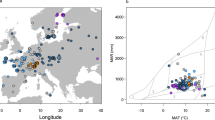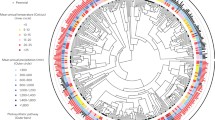Abstract
Elevated atmospheric carbon dioxide (CO2) concentration ([CO2]) enhances plant growth, but this enhancement varies considerably. It is still uncertain which plant traits are quantitatively related to the variation in plant growth. To identify the traits responsible, we developed a growth analysis model that included primary parameters associated with morphology, nitrogen (N) use, and leaf and root activities. We analysed the vegetative growth of 44 ecotypes of Arabidopsis thaliana L. grown at ambient and elevated [CO2] (800 μmol mol−1). The 44 ecotypes were selected such that they were derived from various altitudes and latitudes. Relative growth rate (RGR; growth rate per unit plant mass) and its response to [CO2] varied by 1.5- and 1.7-fold among ecotypes, respectively. The variation in RGR at both [CO2]s was mainly explained by the variation in leaf N productivity (LNP; growth rate per leaf N),which was strongly related to photosynthetic N use efficiency (PNUE). The variation in the response of RGR to [CO2] was also explained by the variation in the response of LNP to [CO2]. Genomic analyses indicated that there was no phylogenetic constraint on inter-ecotype variation in the CO2 response of RGR or LNP. We conclude that the significant variation in plant growth and its response to [CO2] among ecotypes reflects the variation in N use for photosynthesis among ecotypes, and that the response of PNUE to CO2 is an important target for predicting and/or breeding plants that have high growth rates at elevated [CO2].





Similar content being viewed by others
References
Ackerly DD, Cornwell WK (2007) A trait-based approach to community assembly: partitioning of species trait values into within- and among-community components. Ecol Lett 10:135–145
Ainsworth EA (2008) Rice production in a changing climate: a meta-analysis of responses to elevated carbon dioxide and elevated ozone concentration. Global Change Biol. 14:1642–1650. doi:10.1111/J.1365-2486.2008.01594.X
Ainsworth EA et al (2008) Next generation of elevated [CO2] experiments with crops: a critical investment for feeding the future world. Plant Cell Environ 31:1317–1324
Alonso-Blanco C et al (2009) What has natural variation taught us about plant development, physiology, and adaptation? Plant Cell 21:1877–1896. doi:10.1105/Tpc.109.068114
Anyia AO, Herzog H (2004) Water-use efficiency, leaf area and leaf gas exchange of cowpeas under mid-season drought. Eur J Agron 20:327–339
Atwell S et al (2010) Genome-wide association study of 107 phenotypes in Arabidopsis thaliana inbred lines. Nature 465:627–631
Bloom AJ, Burger M, Rubio Asensio JS, Cousins AB (2010) Carbon dioxide enrichment inhibits nitrate assimilation in wheat and Arabidopsis. Science 328:899–903. doi:10.1126/science.1186440
Bush MG, Evans LT (1988) Growth and development in tall and dwarf isogenic lines of spring wheat. Field Crops Res. 18:243–270. doi:10.1016/0378-4290(88)90018-4
Clark RM et al (2007) Common sequence polymorphisms shaping genetic diversity in Arabidopsis thaliana. Science 317:338–342
Curtis PS, Snow AA, Miller AS (1994) Genotype-specific effects of elevated CO2 on fecundity in wild radish (Raphanus raphanistrum). Oecologia 97:100–105. doi:10.1007/BF00317913
Del Pozo A, Ovalle C, Aronson J, Avendano J (2002) Ecotypic differentiation in Medicago polymorpha L. along an environmental gradient in central Chile. II. Winter growth as related to phenology and temperature regime. Plant Ecol 160:53–59
Easlon HM, Nemali KS, Richards JH, Hanson DT, Juenger TE, McKay JK (2014) The physiological basis for genetic variation in water use efficiency and carbon isotope composition in Arabidopsis thaliana. Photosynth Res 119:119–129
Easlon HM, Carlisle E, McKay JK, Bloom AJ (2015) Does low stomatal conductance or photosynthetic capacity enhance growth at elevated CO2 in Arabidopsis? Plant Physiol 167:793–799
Garnier E (1991) Resource capture, biomass allocation and growth in herbaceous plants. Trends Ecol Evol 6:126–131. doi:10.1016/0169-5347(91)90091-B
Hewitt EJ, Smith TA (1975) Plant mineral nutrition. The English University, London
Hikosaka K (2004) Interspecific difference in the photosynthesis-nitrogen relationship: patterns, physiological causes, and ecological importance. J Plant Res 117:481–494
Hikosaka K, Hirose T (1998) Leaf and canopy photosynthesis of C-3 plants at elevated CO2 in relation to optimal partitioning of nitrogen among photosynthetic components: theoretical prediction. Ecol Model 106:247–259
Hikosaka K, Shigeno A (2009) The role of Rubisco and cell walls in the interspecific variation in photosynthetic capacity. Oecologia 160:443–451
Hoffmann MH (2002) Biogeography of Arabidopsis thaliana (L.) Heynh. (Brassicaceae). J Biogeogr 29:125–134. doi:10.1046/J.1365-2699.2002.00647.X
Hunt R (1978) Plant growth analysis. Stud Biol 96:67
Ingestad T (1979) Nitrogen stress in birch seedlings. 2. N, K, P, Ca, and Mg nutrition. Physiol Plant 45:149–157. doi:10.1111/J.1399-3054.1979.Tb01679.X
Koornneef M, Alonso-Blanco C, Vreugdenhil D (2004) Naturally occurring genetic variation in Arabidopsis thaliana. Annu Rev Plant Biol 55:141–172
Krapp A, Quick WP, Stitt M (1991) Ribulose-1,5-bisphosphate carboxylase-oxygenase, other Calvin-cycle enzymes, and chlorophyll decrease when glucose is supplied to mature spinach leaves via the transpiration stream. Planta 186:58–69
Kumar S, Tamura K, Nei M (2004) MEGA3: integrated software for molecular evolutionary genetics analysis and sequence alignment. Brief Bioinform 5:150–163. doi:10.1093/Bib/5.2.150
Lambers H, Poorter H (1992) Inherent variation in growth-rate between higher-plants–a search for physiological causes and ecological consequences. Adv Ecol Res 23:187–261. doi:10.1016/S0065-2504(08)60148-8
Lau JA, Shaw RG, Reich PB, Shaw FH, Tiffin P (2007) Strong ecological but weak evolutionary effects of elevated CO2 on a recombinant inbred population of Arabidopsis thaliana. New Phytol 175:351–362
Leakey ADB, Lau JA (2012) Evolutionary context for understanding and manipulating plant responses to past, present and future atmospheric [CO2]. Philos Trans R Soc B-Biol Sci 367:613–629
Li B, Suzuki JI, Hara T (1998) Latitudinal variation in plant size and relative growth rate in Arabidopsis thaliana. Oecologia 115:293–301
Li Y, Huang Y, Bergelson J, Nordborg M, Borevitz JO (2010) Association mapping of local climate-sensitive quantitative trait loci in Arabidopsis thaliana. Proc Natl Acad Sci USA 107:21199–21204. doi:10.1073/Pnas.1007431107
Medlyn BE (1996) The optimal allocation of nitrogen within the C-3 photosynthetic system at elevated CO2. Aust J Plant Physiol 23:593–603
Meehl GA et al (2007) Global climate projections. In: Solomon S, Qin D, Manning M, Chen Z, Marquis M, Averyt KB, Tignor M, Miller HL (eds) Climate change 2007: the physical science basis. Contribution of Working Group I to the fourth assessment report of the Intergovernmental Panel on Climate Change. Cambridge University, New York
Meerts P, Garnier E (1996) Variation in relative growth rate and its components in the annual Polygonum aviculare in relation to habitat disturbance and seed size. Oecologia 108:438–445
Moya TB, Ziska LH, Namuco OS, Olszyk D (1998) Growth dynamics and genotypic variation in tropical, field-grown paddy rice (Oryza sativa L.) in response to increasing carbon dioxide and temperature. Global Change Biol. 4:645–656. doi:10.1046/j.1365-2486.1998.00180.x
Norton LR et al (1995) Ecotypic differentiation of response to enhanced CO2 and temperature levels in Arabidopsis-thaliana. Oecologia 104:394–396
Poorter H, Navas ML (2003) Plant growth and competition at elevated CO2 on winners, losers and functional groups. New Phytol 157:175–198
Poorter H, Remkes C (1990) Leaf area ratio and net assimilation rate of 24 wild species differing in relative growth rate. Oecologia 83:553–559
Poorter H et al (2005) A genetic analysis of relative growth rate and underlying components in Hordeum spontaneum. Oecologia 142:360–377
Poorter L et al (2008) Are functional traits good predictors of demographic rates? Evidence from five Neotropical forests. Ecology 89:1908–1920. doi:10.1890/07-0207.1
Reich PB, Ellsworth DS, Walters MB (1998) Leaf structure (specific leaf area) modulates photosynthesis-nitrogen relations: evidence from within and across species and functional groups. Funct Ecol 12:948–958
Reich PB et al (2001) Do species and functional groups differ in acquisition and use of C, N and water under varying atmospheric CO2 and N availability regimes? A field test with 16 grassland species. New Phytol 150:435–448. doi:10.1046/j.1469-8137.2001.00114.x
Rey A, Jarvis PG (1998) Long-term photosynthetic acclimation to increased atmospheric CO2 concentration in young birch (Betula pendula) trees. Tree Physiol 18:441–450
Rothstein DE, Zak DR, Pregitzer KS, Curtis PS (2000) Kinetics of nitrogen uptake by Populus tremuloides in relation to atmospheric CO2 and soil nitrogen availability. Tree Physiol 20:265–270
Roumet C, Bel MP, Sonie L, Jardon F, Roy J (1996) Growth response of grasses to elevated CO2: a physiological plurispecific analysis. New Phytol 133:595–603
Stitt M, Krapp A (1999) The interaction between elevated carbon dioxide and nitrogen nutrition: the physiological and molecular background. Plant Cell Environ 22:583–621
Suding KN et al (2008) Scaling environmental change through the community-level: a trait-based response-and-effect framework for plants. Global Change Biol 14:1125–1140
Tonsor SJ, Scheiner SM (2007) Plastic trait integration across a CO2 gradient in Arabidopsis thaliana. Am Nat 169:E119–E140
van der Werf A, Vannuenen M, Visser AJ, Lambers H (1993a) Contribution of physiological and morphological plant traits to a species competitive ability at high and low nitrogen supply–a hypothesis for inherently fast-growing and slow-growing monocotyledonous species. Oecologia 94:434–440
van der Werf A, Visser AJ, Schieving F, Lambers H (1993b) Evidence for optimal partitioning of biomass and nitrogen at a range of nitrogen availabilities for a fast-growing and slow-growing species. Funct Ecol 7:63–74. doi:10.2307/2389868
Ward JK, Kelly JK (2004) Scaling up evolutionary responses to elevated CO2: lessons from Arabidopsis. Ecol Lett 7:427–440
Westoby M, Wright IJ (2006) Land-plant ecology on the basis of functional traits. Trends Ecol Evol 21:261–268. doi:10.1016/j.tree.2006.02.004
Wright IJ, Westoby M (2000) Cross-species relationships between seedling relative growth rate, nitrogen productivity and root vs leaf function in 28 Australian woody species. Funct Ecol 14:97–107
Zerihun A, McKenzie BA, Morton JD (1998) Photosynthate costs associated with the utilization of different nitrogen-forms: influence on the carbon balance of plants and shoot-root biomass partitioning. New Phytol 138:1–11
Acknowledgments
We thank members of the Laboratory of Plant Ecology and Functional ecology at Tohoku University for their support in the plant growth analysis. This work was supported by a Grant-in-Aid for Young Scientists (S) (no. 20677001), a Grant-in-Aid for Scientific Research on Innovative Areas (no. 21114009), the Global COE program (J03), and CREST to K. Hi.
Author contribution statement
R. O. and H. O. conducted the experiments. R. O., H. O. and K. Ha. analysed data. K. Ha. was responsible for the genomic analysis. K. Hi. designed and supervised the research. R. O. and K. Hi. wrote the manuscript. All authors read and approved the manuscript.
Author information
Authors and Affiliations
Corresponding author
Additional information
Communicated by Joy K. Ward.
Electronic supplementary material
Below is the link to the electronic supplementary material.
Rights and permissions
About this article
Cite this article
Oguchi, R., Ozaki, H., Hanada, K. et al. Which plant trait explains the variations in relative growth rate and its response to elevated carbon dioxide concentration among Arabidopsis thaliana ecotypes derived from a variety of habitats?. Oecologia 180, 865–876 (2016). https://doi.org/10.1007/s00442-015-3479-z
Received:
Accepted:
Published:
Issue Date:
DOI: https://doi.org/10.1007/s00442-015-3479-z




